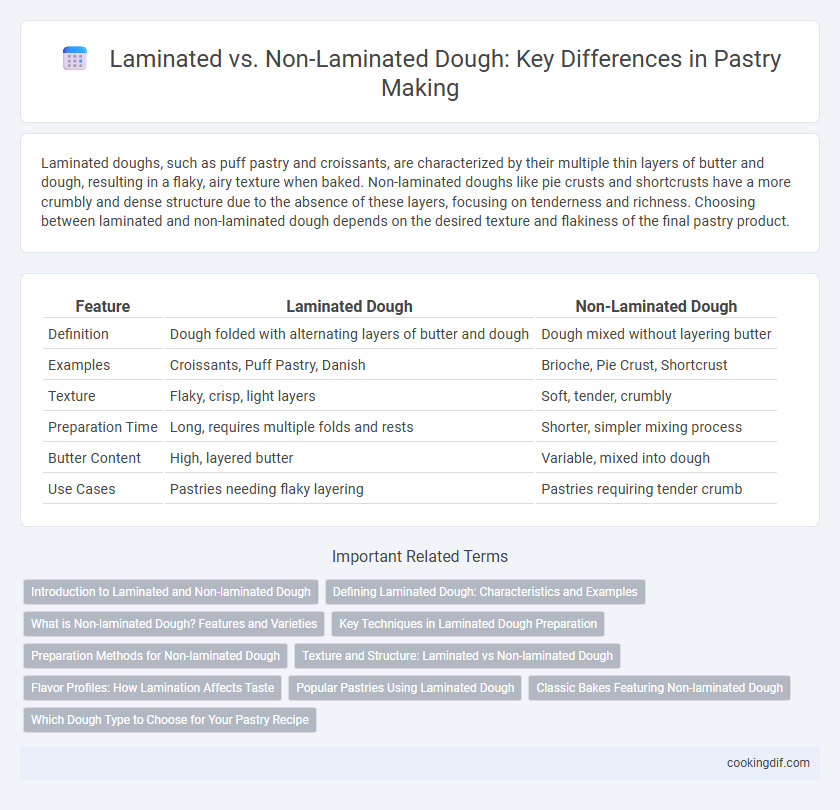Laminated doughs, such as puff pastry and croissants, are characterized by their multiple thin layers of butter and dough, resulting in a flaky, airy texture when baked. Non-laminated doughs like pie crusts and shortcrusts have a more crumbly and dense structure due to the absence of these layers, focusing on tenderness and richness. Choosing between laminated and non-laminated dough depends on the desired texture and flakiness of the final pastry product.
Table of Comparison
| Feature | Laminated Dough | Non-Laminated Dough |
|---|---|---|
| Definition | Dough folded with alternating layers of butter and dough | Dough mixed without layering butter |
| Examples | Croissants, Puff Pastry, Danish | Brioche, Pie Crust, Shortcrust |
| Texture | Flaky, crisp, light layers | Soft, tender, crumbly |
| Preparation Time | Long, requires multiple folds and rests | Shorter, simpler mixing process |
| Butter Content | High, layered butter | Variable, mixed into dough |
| Use Cases | Pastries needing flaky layering | Pastries requiring tender crumb |
Introduction to Laminated and Non-laminated Dough
Laminated dough consists of multiple layers created by folding butter into the dough, resulting in a flaky and airy texture ideal for croissants and puff pastries. Non-laminated dough lacks these layers and tends to be denser and more crumbly, commonly used in cookies, pies, and tarts. Understanding the structural differences between laminated and non-laminated doughs is essential for selecting the right pastry technique and achieving desired texture outcomes.
Defining Laminated Dough: Characteristics and Examples
Laminated dough is defined by its multiple layers of dough and fat, created through a process of repeated folding and rolling, resulting in a flaky, airy texture. Common examples include croissants, puff pastry, and Danish pastry, which are known for their crisp, tender layers and buttery flavor. In contrast, non-laminated dough lacks these layers, producing denser, more uniform baked goods such as brioche or choux pastry.
What is Non-laminated Dough? Features and Varieties
Non-laminated dough is a type of pastry dough that lacks the multiple thin layers characteristic of laminated dough, resulting in a denser and more uniform texture. Features include a softer crumb, less flakiness, and quicker preparation, commonly seen in doughs like shortcrust and choux. Varieties such as tart crusts, pie dough, and cookie bases exemplify non-laminated dough, prized for their sturdy structure and versatile baking applications.
Key Techniques in Laminated Dough Preparation
Laminated dough preparation involves precise layering of butter and dough through repeated folding and rolling, creating distinct flaky layers essential for croissants and puff pastries. Temperature control is critical to maintain butter consistency and prevent melting, ensuring optimal lamination and rise during baking. Mastery of techniques like butter encasing, rest periods between folds, and even pressure application directly impacts the texture and flakiness of laminated dough products.
Preparation Methods for Non-laminated Dough
Non-laminated dough preparation involves mixing ingredients until just combined to maintain a tender crumb rather than layers. Techniques emphasize minimal handling and often include methods like creaming butter with sugar or folding flour in gently to avoid gluten overdevelopment. Unlike laminated doughs, which require repeated rolling and folding with butter for flaky strata, non-laminated doughs rely on chemical leaveners or steam for rise and texture.
Texture and Structure: Laminated vs Non-laminated Dough
Laminated dough features multiple layers of butter folded within the dough, creating a flaky, airy texture ideal for croissants and puff pastries. Non-laminated dough produces a denser, more uniform crumb, suitable for items like cookies and pie crusts. The lamination process significantly enhances the structure by incorporating thin, crisp layers, whereas non-laminated dough relies on gluten development and fat distribution for its texture.
Flavor Profiles: How Lamination Affects Taste
Laminated doughs, such as puff pastry or croissants, develop a rich, buttery flavor with a delicate, flaky texture due to the multiple layers of butter trapped between dough sheets. Non-laminated doughs, like pie crust or shortcrust pastry, offer a tender, crumbly bite with a more straightforward, buttery or savory taste. The lamination process enhances complexity and mouthfeel, creating a distinct taste experience compared to simpler, denser non-laminated pastries.
Popular Pastries Using Laminated Dough
Laminated dough is essential for creating flaky, layered pastries like croissants, Danish pastries, and puff pastry, where alternating layers of butter and dough produce a light, airy texture. Non-laminated dough, such as shortcrust or choux, is commonly used for tarts, pies, and eclairs, offering a denser, crumbly or airy structure without distinct layers. The choice between laminated and non-laminated dough significantly impacts the pastry's texture, flakiness, and overall mouthfeel.
Classic Bakes Featuring Non-laminated Dough
Classic bakes featuring non-laminated dough, such as brioche and challah, emphasize rich textures and tender crumb structures without the layered flakiness found in laminated varieties like croissants or puff pastry. Non-laminated doughs rely on thorough mixing and proofing techniques to develop gluten and incorporate air, resulting in soft, light, and moist baked goods. These doughs excel in recipes where a delicate balance of density and softness is desired, providing a versatile base for sweet and savory applications.
Which Dough Type to Choose for Your Pastry Recipe
Laminated dough, characterized by its multiple layers of butter and dough, creates a flaky, airy texture ideal for croissants and puff pastries, while non-laminated doughs, such as shortcrust or choux, offer a denser, more crumbly or creamy result perfect for tarts and eclairs. Choosing between laminated and non-laminated dough depends on the desired texture and pastry type; laminated dough requires precise temperature control and patience, whereas non-laminated dough is generally quicker to prepare and more versatile. Understanding these differences helps bakers select the optimal dough type, ensuring pastry recipes yield the intended flavor and mouthfeel.
Laminated vs Non-laminated for dough types Infographic

 cookingdif.com
cookingdif.com